Israel's Gaza bombing campaign is the most destructive of this century, analysts say
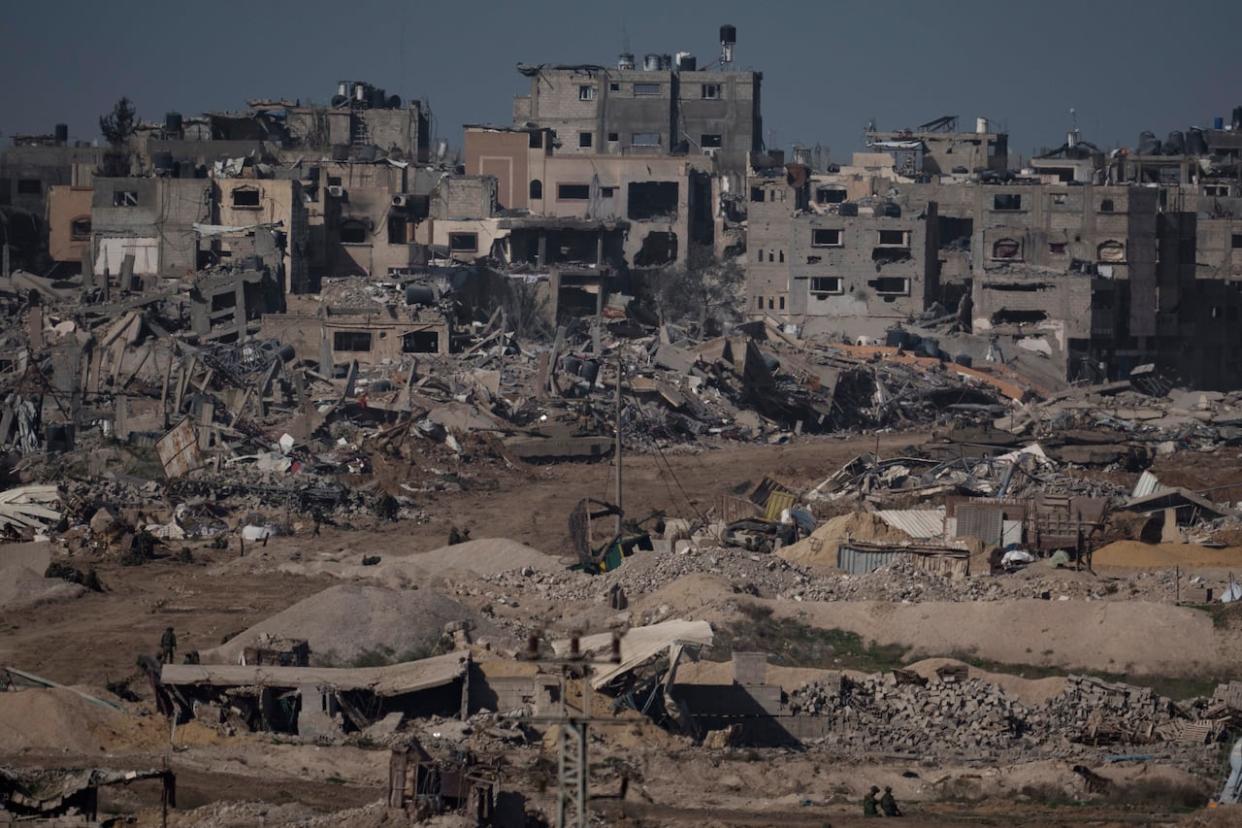
Few outside journalists have been able to enter Gaza, but developments in satellite technology over the past decade have made it possible to accurately assess from space the destruction brought by the war in the small Palestinian enclave.
Some of the tools being used to track bomb damage in Gaza were developed to measure deforestation or damage following natural disasters.
In addition to taking bird's-eye-view photos of rooftops and streets, satellites can aim radar at an angle, causing it to bounce off buildings and scatter in a way that allows operators to "see" not only rooftops but also the sides of structures. Computers can then compare it to baseline data collected before the bombs hit.
Corey Scher of the City University of New York Graduate Center and Jamon Van Den Hoek of Oregon State University are experts in mapping damage during wartime. They've studied the effects of aerial bombing and artillery strikes in conflicts ranging from Syria to Yemen to Ukraine.
They applied data from the Copernicus Sentinel-1 satellite to Gaza and found levels of destruction unprecedented in recent conflicts, Scher told CBC News.
"We're adapting and building off of almost two decades of research that's mainly gone into catastrophe impact mapping, so after seismic hazards or floods, and adapting those methods to war and conflict," he said.
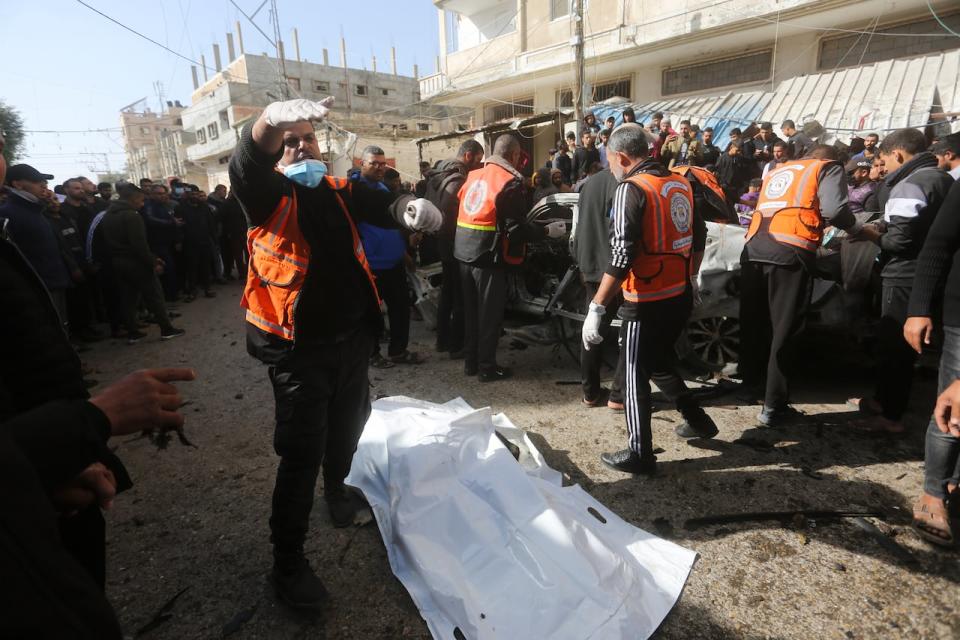
Palestinians remove the body of a person killed in an Israeli airstrike on a car in Rafah, Gaza Strip, Friday, Dec. 22, 2023. (Hatem Ali/Associated Press)
As of Dec. 22, 20,057 Palestinians have been killed in Gaza since the war started, according to the Hamas-run Gaza Health Ministry. During the Oct. 7 attack, Hamas militants killed about 1,200 people in Israel and took about 240 hostages back to Gaza, according to Israel.
The intensity of bombing in Gaza is something the researchers said they've never seen before.
"It's just the sheer speed of the damage," said Van Den Hoek. "All of these other conflicts that we're talking about [Ukraine, Syria, Yemen] are years long. This is a little over two months. And the sheer tempo of the bombing — not just the scale of it but the sheer tempo — there's nothing that tracks [like] this in such a short timeframe."
The two researchers have worked extensively on Ukraine since Russia launched its full-scale invasion in February 2022.
"The extent and the pace of damage in Gaza only compares to the heaviest-hit cities that we've seen in Ukraine," said Scher. "And those were much smaller areas. Mariupol and Bakhmut by area are smaller and the built-area density and clustering of structures was also much less."
United Nations figures have yet to be finalized for both conflicts, but the ones released to date show that Israeli forces have killed approximately twice as many women and children in two months in Gaza as Russian forces have killed in Ukraine in nearly two years.
"Where we do have comparable surveys in Ukraine, Gaza is really standing out as much faster and much larger in extent. A much larger portion of the built environment is affected in Gaza," said Scher.
Van Den Hoek said that while Israel's 2021 bombing of Gaza damaged several hundred buildings, in 2023, an equivalent or even larger number of freshly damaged buildings are being detected in each daily data update.
"Somewhere around a third, maybe 40 per cent of all structures in Gaza, are showing some degree of damage, some of which are likely destroyed. In north Gaza and Gaza City, we see much higher rates approaching two-thirds," he said.
More damage than Dresden
The Financial Times did a statistical analysis that compared Gaza to the Allied bombing campaign over Germany during the Second World War.
Three cities in Germany were effectively destroyed from the air during that war: Cologne, Hamburg and Dresden. In Hamburg and Dresden, a mix of high explosives and incendiary bombs created the notorious "firestorm" conditions that caused streets to melt.
Data analyzed by Scher and Van Den Hoek shows that by Dec. 5, the percentage of Gaza's buildings that had been damaged or destroyed already had surpassed the destruction in Cologne and Dresden, and was approaching the level of Hamburg.
Israel Defence Forces (IDF) dropped around 1,000 bombs a day in the first week of the campaign and said that it had conducted more than 10,000 airstrikes on Gaza as of Dec. 10. The number of aircraft involved or bombs dropped on each mission is unknown, but Israel's main strike aircraft are capable of carrying six tons of bombs each.
For context, London was hit with an estimated 19,000 tons of bombs during the eight months of the Blitz, and the atomic bomb that destroyed Hiroshima was equivalent to 15,000 tons of high explosive.
The figures for airstrikes do not take into account the many thousands of artillery shells fired into Gaza since Oct. 7.
Biden denounces 'indiscriminate bombing'
Israel's bombing tactics have drawn criticism from its strongest allies. On Dec. 12, U.S. President Joe Biden warned that Israel had the world's sympathy following the Oct. 7 massacre but it's "starting to lose that support by indiscriminate bombing."
In a year-end interview with CBC News's chief political correspondent, Rosemary Barton, Prime Minister Justin Trudeau said that "the voices from Israel's strongest friends, like Canada, like Australia, especially like the United States ... are becoming increasingly concerned that … the short-term actions being taken by Israel are actually putting at risk the long-term safety and even support for a Jewish state into the future."
Israel's Prime Minister Benjamin Netanyahu has vowed to destroy Hamas, and on Dec. 25 said Israel's campaign is "not close to being over."
"We're not stopping, he said. "We're continuing to fight, and we're intensifying the fighting in the coming days. It's going to be a long war that's not close to ending."
Israel has pushed back on the criticism, arguing its forces are conducting themselves no differently than U.S. troops did when they faced difficult urban warfare against the Islamic State in Iraq and Syria, or when they fought the Taliban in Afghanistan.
But the intensity of Israel's air campaign, the size of the munitions used and the number of civilians killed as a result all differ from the Western allies' campaigns in the Middle East and Afghanistan.
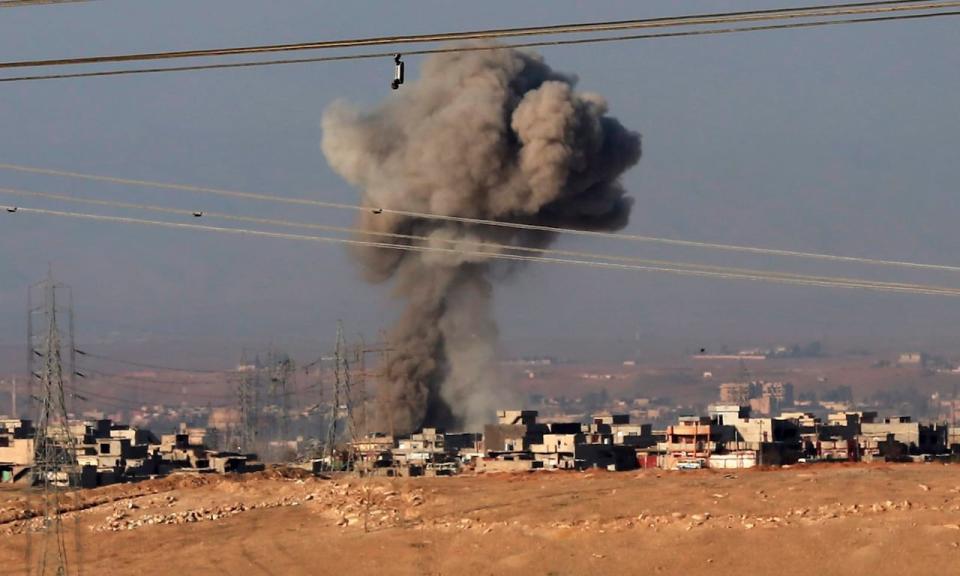
Smoke rises after an airstrike by U.S.-led coalition warplanes during fighting between Iraqi special forces and Islamic State militants on the western side of Mosul on Feb. 25, 2017. (Khalid Mohammed/The Associated Press)
The largest bomb that coalition forces typically used in bombing Islamic State forces in Mosul or in their Syrian urban stronghold of Raqqa were 500-pound Mk-82 bombs. Israel has pounded Gaza with bombs of up to 2,000 pounds.
Also, Western coalition forces did not drop unguided bombs (also known as "iron bombs" or "dumb bombs") in or near built-up areas in their wars against the Taliban and al-Qaeda, Ba'athist Iraq, the Iraqi insurgency or the Islamic State.
Israel, by contrast, has made extensive use of unguided munitions that are predictably much less accurate than the guided versions it has in its inventories.
CBC News has reached out to the Israeli embassy for comment, but has not received a response.
In a video posted to X, Israeli Air Forces Chief of Staff Brigadier-General Omer Tischler said "dumb bombs ... are standard munitions regularly used by militaries worldwide," and that the claim these are indiscriminate and cause uncontrollable damage is "misleading."
Overlapping "kill radius" circles
In recent years, the U.S. has developed non-explosive munitions that can reduce collateral damage almost to zero. It used such a missile — the Hellfire R9X — to kill al-Qaeda leader Ayman al-Zawahiri in Kabul in August 2022.
The building he was in suffered no major damage and the family members with him were all uninjured.
Israel, meanwhile, has used the most destructive and lethal non-nuclear weapons in its arsenal in the very heart of Gaza's most densely-populated neighbourhoods.
Satellite imagery has revealed hundreds of new craters more than 10 metres wide across the Gaza Strip that are normally associated only with 2,000-pound bombs.
In some areas of Gaza, so many of the bombs have been dropped that the multiple overlapping "kill radius" circles cover entire districts.
Machine learning, machine targeting
Although Israel has objected to President Biden's characterization of its campaign as "indiscriminate," the IDF has acknowledged that it is using new artificial intelligence tech called "Gospel" to identify targets for its sorties into Gaza.
Little is known about the inputs that are used by that AI program, or the parameters the IDF has set for it, but Israeli users have described a system that generates new targets for bombing at many times the rate of human decision-making.
Former IDF chief of staff Avi Kochavi told an Israeli publication in June that the Gospel system is "a machine that produces vast amounts of data more effectively than any human, and translates it into targets for attack."
Gospel collates intelligence reports to generate likely home addresses for people Israel believes may be members of Hamas and other militant groups in Gaza. Those homes can then be added to the target list.
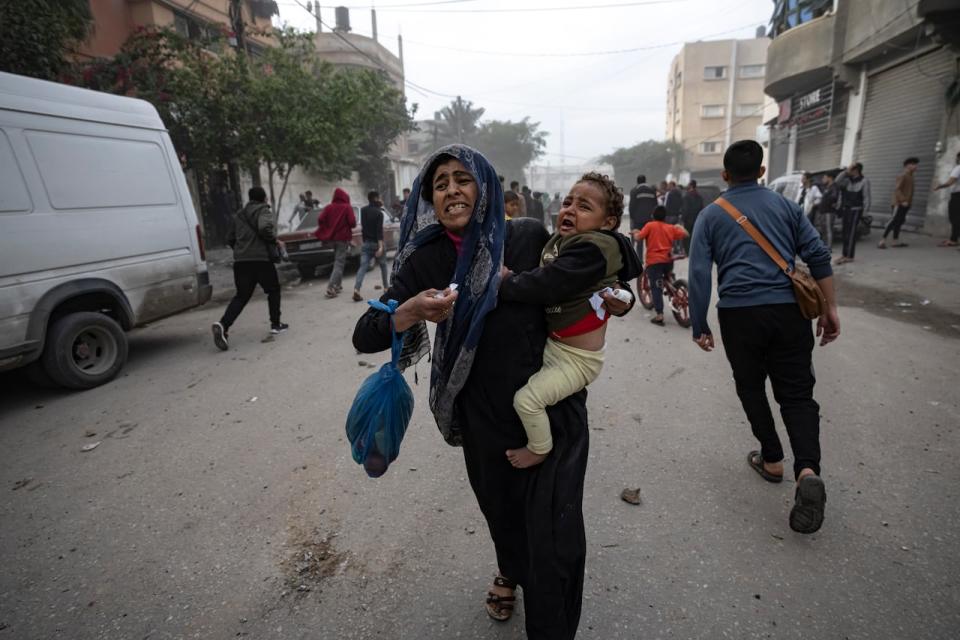
Palestinians evacuate from a site hit by an Israeli bombardment on Rafah, southern Gaza Strip, Wednesday, Dec. 20, 2023. (Fatima Shbair/Associated Press)
Even if there are no mistakes, such targeting with large bombs typically will kill family members and neighbours of the target, as well as passers by.
On Oct. 31, the IDF used a 2,000-pound bomb on the crowded Jabaliya refugee camp to kill Hamas member Ibrahim Biari. The bomb, which has a lethal fragmentation area equivalent to about 60 soccer fields, left a vast crater, killed more than 100 civilians and left hundreds more homeless.
The IDF says they have no other choice.
Earlier this month, IDF spokesperson Lt. Col. Jonathan Conricus told CBC's Power & Politics, "if we don't finish this mission, if we don't take out Hamas, then they will come back" and "try to do worse" than the Oct. 7 attacks.
Van Den Hoek and Scher said science can show the effects of such bombing but can't get inside the minds of those doing the targeting.
"We can't talk about 'indiscriminate' because that has intentionality loaded into it," said Van Den Hoek. "Indiscriminate means that you're hitting targets that are not intended, and we don't have any data on that. We can't talk about the precision of weaponry …. But we can talk about the breadth of it and the pace of it, and align with all these other data points.
"At some point, if everything becomes a target, then claims over precision are kind of meaningless. If everything is a target, what's the point of precision?"
Casualties tell the tale
The effect of Israel's approach to bombing has been seen both in the sheer numbers of casualties and in the identities of those being killed.
In just two months, the bombing has killed one per cent of Gaza's entire population. Allied bombing of Germany, by comparison, killed a smaller percentage of the German population over the course of the entire Second World War.
It's not clear how many of Gaza's 20,000 reported fatalities are civilians and how many are members of militant groups. Israel claims that it has killed one militant for every two civilians, a rate that Conricus called "tremendously positive."
For its part, the IDF said they are conducting a "precise, focused and process-based campaign," according to Tischler.
But even accepting Israel's figures and deducting them from the total reported deaths indicates that, in just two months, Israeli forces in Gaza have killed more civilians than the U.S.-led coalition killed in the first nine months of its invasion of Iraq, a country with more than 10 times the population.
The U.S. bombing campaign of Afghanistan following the attacks of Sept. 11, 2001, is thought to have caused about 1,000 to 1,200 civilian casualties in its first three months.
Israeli bombing becoming harsher
The British NGO Action on Armed Violence has compared the death toll of Israeli airstrikes in previous rounds of Gaza fighting and found it to be several times higher in 2023 than in 2012 (Operation Pillar of Defence), 2014 (Operation Protective Edge), or 2021 (Operation Wall Guardian).
Each airstrike causing civilian casualties in 2023's Operation Swords of Iron produced just over 10 fatalities on average, compared to 1.3, 2.5 and 1.7 per fatal bombing in those previous bouts of bombing.
"This surge points to a potential escalation in military tactics, payload capacity or a shift in targeting policies that appear to have disregarded the safety and lives of the civilian population to a greater extent than in previous operations," the NGO concluded.
Comparisons with past conflicts reveals another anomaly of the casualty lists of 2023: the high percentage of women and children killed.
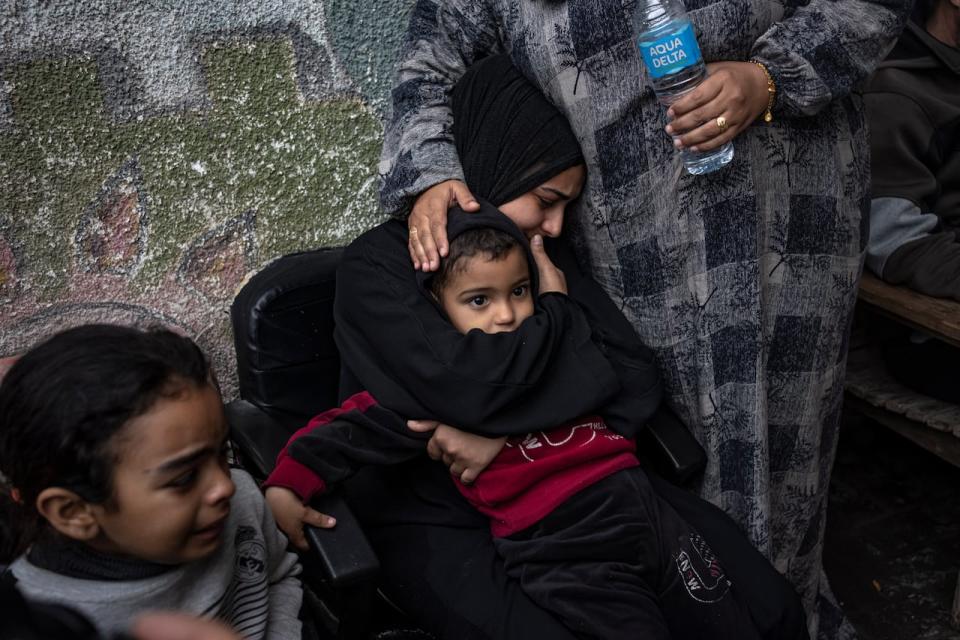
Palestinians mourn their relatives killed in the Israeli bombardment of the Gaza Strip at the hospital in Rafah, southern Gaza, on Dec. 21, 2023. (Fatima Shbair/Associated Press)
Israel argued after the 2014 war that the relatively low proportion of women and children among the dead proved that it was making efforts to avoid harming civilians, and supported its claim that 40 to 50 per cent of those killed by the IDF that year were members of militant groups such as Hamas.
According to figures compiled by the UN Refugee Works Agency, women and children accounted for just 37 per cent of the fatalities in 2014. The rest were adult men, including combatants and civilians.
But in 2023, women and children account for about 70 per cent of the reported death toll, according to the Gaza Health Ministry's figures. It may be that later studies will revise the casualty lists and turn up what for now appears to be missing: the large number of excess adult male deaths that normally would be expected when military power is focused on killing enemy combatants and avoiding civilian casualties.
Women in Gaza appear to be dying at a rate similar to men — and both are being outpaced by the death rate for minors in a territory UN Secretary General Antonio Guterres has described as "a graveyard for children."
The IDF say they have killed about 8,000 members of Hamas and affiliated groups in Gaza, presenting a discrepancy with Gaza health authorities, who have reported only about 6,000 adult male deaths.
The 20,000 dead so far reported in Gaza more closely resembles a random sampling of its civilian demographics than the ranks of an all-male fighting force such as Hamas.


